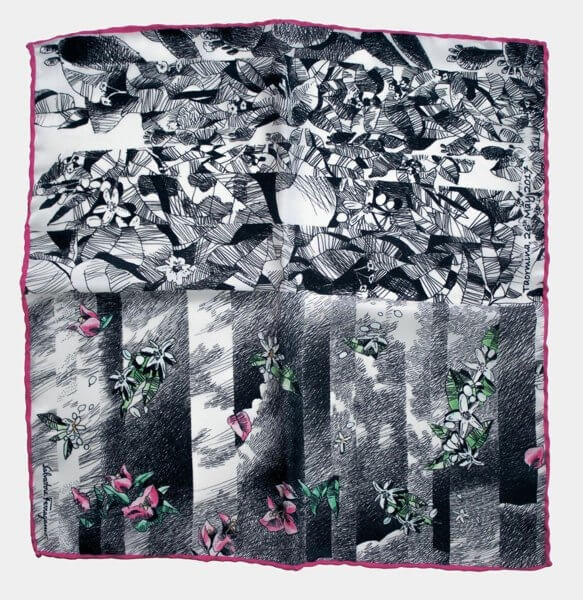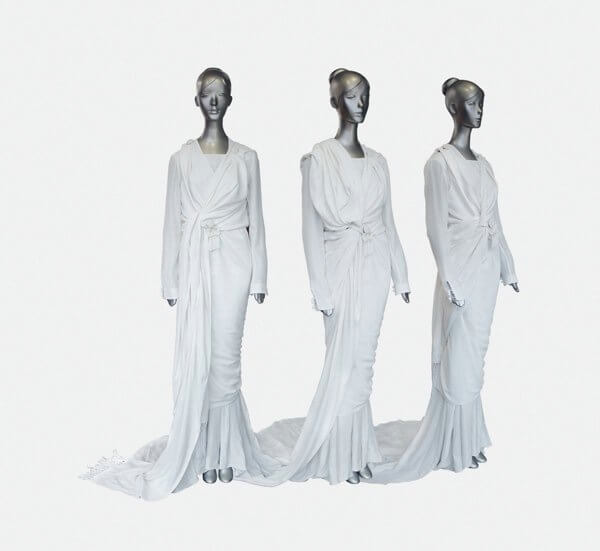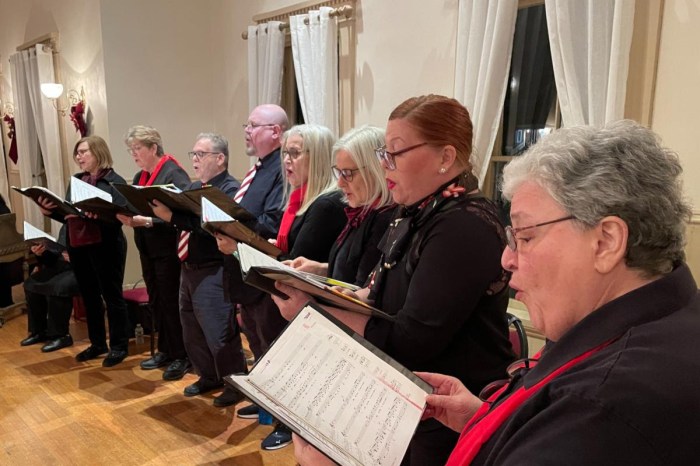By Tammy Scileppi
Newer immigrants have been contributing many layers of cultural authenticity to Queens’ multi-ethnic pot, but those who were once considered new immigrants back in the early 1900s don’t seem to be getting as much recognition these days.
So it’s time to celebrate their unique history and heritage.
The Italian-American story can be told through the myriad of contributions they and their descendants have made to the fabric of American society as philosophers, explorers, adventurers, industrialists, scientists, educators, politicians, fashion designers, and everyday extraordinary people.
If you’d like to learn more about this rich culture and its fashion roots, and what’s really behind the Made in Italy label, stop by the Art Center at Rosenthal Library in Queens College, where a free exhibition called “The Fabric of Cultures: Systems in the Making” is now on display through Dec. 15.
With its focus on Made in Italy, the exhibit is a team effort by artists, designers, students and the community, as they reflect on the art of making, craftsmanship and technology. Among the highlights is the debut of CUNY student Christina Trupiano’s work: a re-creation of the Tanagra Dress, originally made by Italian activist and dress designer Rosa Genoni, back in 1908. A film by Massimo Mascolo and Claudio Napoli about Trupiano’s work will also be screened.
“Visitors will take away an appreciation of beauty and taste in the arts, including, of course, the culinary arts, and realize what an enormous role Italians have had in building the garment industry in the U.S.,” said exhibition curator Eugenia Paulicelli, PhD, a professor & director of Italian Studies, Fashion Studies & Comparative Literature at Queens College.
“The Fabric of Cultures” offers a special opportunity to view the new Made in Italy from New York, a global fashion city and a design hub, through the Tek-Tile project by the Pratt/Brooklyn Fashion and Design Accelerator, and NY-based companies such as Tabii Just and HVRMINN, according to the curator.
With an eye toward innovative techniques and designs, the Made in Italy concept still represents quality and craftsmanship and links to local identity and history, while symbolizing care and attention to detail and aesthetic, ethics, and know-how.
But few people know that along with art and fashion, feminism and activism also flourished in Italia, back in the early 1900s. Fashion designer, teacher, feminist and labor rights activist Rosa Genoni (1867–1954), was born near Milan. After perfecting her craft as a seamstress in Paris, she moved back to her homeland, determined to develop a ‘Made in Italy’ sensibility and bring awareness to creative production there.
Genoni’s inspiration came from three distinct periods: early Renaissance, Greco-Roman and classical antiquity, and the modern. Evening wear was inspired by the Renaissance painters Sandro Botticelli (“Primavera”) and Pisanello.
She incorporated draping, folding, girding and pinning – building in the ability for the wearer to transform her Tanagra dress – which was inspired by draping in the Tanagra figurines, a mold-cast type of Greek terracotta figurines produced in the later fourth century BC, primarily in the Boeotian town of Tanagra.
The figures depict real women (and some men and boys) in everyday costume, with familiar accessories like hats, wreaths or fans.
“She advocated for an Italian fashion at the time in which there was only one fashion: Paris Fashion,” said Paulicelli, who wrote a book about Genoni.
“Viewers can see the dress and the videos we produced with the dress, worn by two models who bring not only the dress back to life but also the history of Italy, fashion, the role of women and women’s rights. Genoni’s Tanagra Dress does not exist anywhere. We have reproduced it for the first time, but we did it from a modern perspective.”
Like other immigrant groups, Italian immigrants came to America to seek a new and better life, and many – five million-plus between 1876 and 1930 – first arrived in New York City through Ellis Island. In 1913, a record number immigrated from Northern and Southern Italy, Among them, many artisans. There are now 26 million or so Americans of Italian descent living in the country.
Since that time, generations of Italian Americans have helped shape our society. They brought with them a love of family and their fiercely local identifications, or “campanilismo.”
The city boasts the largest Italian-American population. According to a recent United Census Bureau estimate, 17.8 million New Yorkers are of Italian descent. Popular communities in Queens include Howard Beach, Ozone Park, Middle Village, and Whitestone.
Early Italian immigrants became a vital part of the labor force, working in mining, textiles, and clothing manufacturing.
Emphasizing local traditions and culture, any of today’s Italian designers make sure their collections are linked to the place in which they are made. The designers and companies included in the exhibition exemplify this dialogue and dynamic. Among them: Cesare Attolini, Antonio Marras, Orange Fiber and Salvatore Ferragamo, and “Arte e Ricamo,” a women-run company that works for prestigious Italian and international brands from Emilio Pucci (shown in the exhibit) to Dolce & Gabbana, Tom Ford, Versace, Vivienne Westwood, and Fendi.
Exhibit goers will enjoy a potpourri of regional experiences, accents and know-how from the north: Arte e Ricamo, Emilio Pucci, Ferragamo, Silvia Giovanardi; from the south: Calabria—FraccyG, Emanuela Errico, Maria Francesca Nigro, Cangiari/Goel; Sicily—Giulietta Salmeri, Marzia Donzelli, (Arca Textile Lab) Orange Fiber; Sardinia—Antonio Marras; or from a city, Naples in the case of Attolini.
The Fabric of Cultures is part of a larger, partly digital, pedagogic and research project directed by the curator.
“You can expect to see the work behind a beautiful garment and appreciate some important and innovative realities in the fashion and textile industry now in Italy,” said Paulicelli.
“Explore Italian craftsmanship in conversation with research in science and technology, as with Orange Fiber/Ferragamo.” The luxury brand Salvatore Ferragamo, launched a capsule collection using a new textile developed from the skin of discarded orange skins.
Viewers will surely appreciate the craftsmanship of the Neapolitan jacket made in Naples by Cesare Attolini and worn by the actor Toni Servillom, who starred in Paolo Sorrentino’s film “La Grande Bellezza” (“The Great Beauty” won an Oscar for best foreign film in 2013).
“People will discover important work that defines what I call the ‘New Made in Italy’ — attentive to sustainability and environmental issues, to craftsmanship and technology. This is also reflected in the Calabrian-based company Cangiari/Goel and the two beautiful dresses we are showing in the exhibit,” said Paulicelli.
So what message will viewers take away from this exhibit?
“The richness of Italian fashion linked to cultural identity, tradition and the work of many skilled people, especially women,” said Paullicelli, who wanted to translate into practice what her students were reading. According to the curator, Italian history, fashion, and literature are very much connected both in the present and in the examination of the past.
The exhibition also highlights names not completely known to the American audience and market; it also reveals how many stories are hidden in a dress or a piece of fabric.
“Wearing, buying, and eating goes beyond that simple act; it becomes a way of traveling and desiring the country where these products are made. What is around a product that makes it special as an experience to the point that we feel is authentic? The importance of local tradition, beauty with the combination of design and technology. The Made in Italy has an aura that especially for non-Italians, means all these things,” said Paulicelli, who was born in Canosa, a town in the region of Puglia in the south of Italy.
She added: “So I hope that as a college, we can connect even more with the Italian community and others at Queens.”
Paulicelli, who has been teaching at Queens College since 1992, also founded a Made in Italy Festival Arts & Cultures this fall in conjunction with the exhibition; it featured film screenings, Q&A with scholars and directors.
An exhibit of Federico Fellini’s drawings of food at the Queens College Tech Incubator is set for Nov. 16. “Fellini used to draw all the time. This was integral to his visionary imagination and typical of his films. Food and eating are very much present in his films and they help to convey a sense of corporeality between sexiness and grotesque,” she noted.
The festival will take place along with a wonderful food event, organized in conjunction with the International Week of Italian Food in the world.
“I think that it is very important to teach Italian language and culture connected to the wider world, and in connection with the American and Italian experience and history,” Paulicelli said.





































